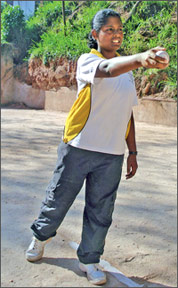Stoolball - it is cricket in the air
Lt.Col.A.A.de Alwis, M.Ed. (McGill)
STOOLBALL: Tradition has it that the ancient game of Stoolball in one
form or another was the progenitor of cricket, rounders and baseball.
References have been made to it in English literature one of which reads
as follows:
"At stoolball, Lucia let us play
For sugar cakes and wine"
(1648 Robt. Herrick in Hesperides)
 |
 |
 |
| Bowler Sheroon Shaukett
about to deliver the ball. |
In strike position -
thatís Sachinthani Dissanayake in half saree. |
Ready to strike -
batswoman Sheranja Weerakody in track kit. |
The game of Stoolball was sometimes called "cricket in the air" as
the soft leather ball is bowled not on the ground but underarm at a
board, a foot square, fixed to the top of a post defended by a player
with a bat. The word "stool" is old Sussex dialect for a tree stump (the
post). It was a game played originally between two tree stumps and the
flats of stools used by milkmaids were the boards fixed to the top of
the stumps to which the ball was directed.
Today, the distance of 16 yards between posts is set by the Stoolball
Association of England and the bowlers within eight ball overs use a
bowling crease set 10 yards from each wicket. The rules of the game are
very similar to that of cricket with teams comprising of eleven or eight
players and accommodating a strike for four and six runs with the usual
runs earned for running between wickets closely watched by a
wicketkeeper.
As the game in the main is popular among girls and women, there were
times that taxed the good judgement of the umpires. There was a rule
that prevented Victorian women from catching the ball in the petticoats
they wore and on one celebrated occasion the umpire ruled the striker as
"out" when the air-borne ball finally lodged in a fielder's coiffure.
Rude remarks that followed were said to have been heard and which nearly
ended play.
As for equipment, the bats are similar to enlarged "fives" bats and
the balls are somewhat smaller and not so hard as cricket balls. No
gloves or other protective equipment is used. There is no special dress
code - teams appearing in "sweats", divided skirts, jeans and tops and
deck shoes. In Victorian England, straw hats were de rigueur as seen in
a group photograph portraying probably the Northern Lovelies at their
Stoolball Meet with the Southern Sweeties. The Sussex County Magazine of
1928 carried an article by Major W. W. Grantham K. C. who popularized
the sport in several countries.
Reporting on a visit to Ceylon in 1928, he observed that the game had
been played in the Island for some years and published a photograph of a
match in progress at Hillwood College, Kandy with the players "in their
picturesque native dress".
The photograph depicts the barefoot juniors of Hillwood in Kandyan
half saree playing the game on the extant Hillwood Stoolball Court.
A souvenir bat was presented to Major Grantham by the Lady British
missionary principal of Hillwood and which is presently on display, with
Stoolball bats from many countries, in the Museum of the Stoolball
Association of England in Horsham, UK.
A revival of the game at Hillwood is currently underway due to the
special interest taken by Principal Sudharshini Hettige and Surani
Galagoda, the Prefect of Games with advice from the Stoolball
Association of England.
The game was played at Hillwood until after WW.2 and thereafter
disappeared from the games program. |


